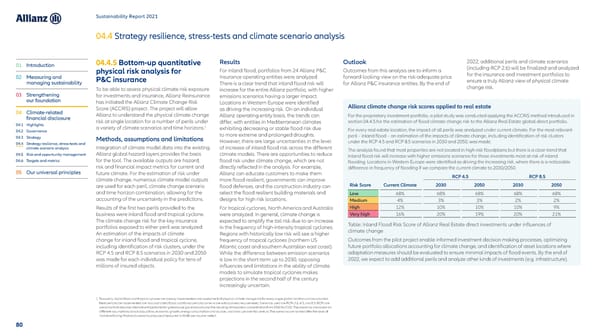Sustainability Report 2021 04.4 Strategy resilience, stress-tests and climate scenario analysis 01 Introduction 04.4.5 Bottom-up quantitative Results Outlook 2022, additional perils and climate scenarios physical risk analysis for For inland flood, portfolios from 24 Allianz P&C Outcomes from this analysis are to inform a (including RCP 2.6) will be finalized and analyzed 02 Measuring and P&C insurance Insurance operating entities were analyzed. forward-looking view on the risk-adequate price for the insurance and investment portfolios to managing sustainability There is a clear trend that inland flood risk will for Allianz P&C insurance entities. By the end of ensure a truly Allianz view of physical climate To be able to assess physical climate risk exposure increase for the entire Allianz portfolio, with higher change risk. 03 Strengthening for investments and insurance, Allianz Reinsurance emissions scenarios having a larger impact. our foundation has initiated the Allianz Climate Change Risk Locations in Western Europe were identified Score (ACCRiS) project. The project will allow as driving the increasing risk. On an individual Allianz climate change risk scores applied to real estate 04 Climate-related Allianz to understand the physical climate change Allianz operating entity basis, the trends can For the proprietary investment portfolio, a pilot study was conducted applying the ACCRiS method introduced in financial disclosure risk at single location for a number of perils under differ, with entities in Mediterranean climates section 04.4.5 for the estimation of flood climate change risk to the Allianz Real Estate global direct portfolio. 04.1 Highlights 1 04.2 Governance a variety of climate scenarios and time horizons. exhibiting decreasing or stable flood risk due For every real estate location, the impact of all perils was analyzed under current climate. For the most relevant 04.3 Strategy Methods, assumptions and limitations to more extreme and prolonged droughts. peril – inland flood – an estimation of the impacts of climate change, including identification of risk clusters 04.4 Strategy resilience, stress-tests and However, there are large uncertainties in the level under the RCP 4.5 and RCP 8.5 scenarios in 2030 and 2050, was made. climate scenario analysis Integration of climate model data into the existing of increase of inland flood risk across the different The analysis found that most properties are not located in high-risk floodplains but there is a clear trend that 04.5 Risk and opportunity management Allianz global hazard layers provides the basis climate models. There are opportunities to reduce inland flood risk will increase with higher emissions scenarios for those investments most at risk of inland 04.6 Targets and metrics for the tool. The available outputs are hazard, flood risk under climate change, which are not flooding. Locations in Western Europe were identified as driving the increasing risk, where there is a noticeable risk and financial impact metrics for current and directly reflected in the analysis. For example, difference in frequency of flooding if we compare the current climate to 2030/2050. 05 Our universal principles future climate. For the estimation of risk under Allianz can educate customers to make them RCP 4.5 RCP 8.5 climate change, numerous climate model outputs more flood-resilient, governments can improve are used for each peril, climate change scenario flood defenses, and the construction industry can Risk Score Current Climate 2030 2050 2030 2050 and time horizon combination, allowing for the select the flood resilient building materials and Low 68% 68% 68% 68% 68% accounting of the uncertainty in the predictions. designs for high risk locations. Medium 4% 3% 3% 2% 2% Results of the first two perils provided to the For tropical cyclones, North America and Australia High 12% 10% 10% 10% 9% business were inland flood and tropical cyclone. were analyzed. In general, climate change is Very high 16% 20% 19% 20% 21% The climate change risk for the key insurance expected to amplify the tail risk due to an increase Table: Inland Flood Risk Score of Allianz Real Estate direct investments under influences of portfolios exposed to either peril was analyzed. in the frequency of high-intensity tropical cyclones. climate change An estimation of the impacts of climate Regions with historically low risk will see a higher change for inland flood and tropical cyclone, frequency of tropical cyclones (northern US Outcomes from the pilot project enable informed investment decision making processes, optimizing including identification of risk clusters, under the Atlantic coast and southern Australian east coast). future portfolio allocations accounting for climate change, and identification of asset locations where RCP 4.5 and RCP 8.5 scenarios in 2030 and 2050 While the difference between emission scenarios adaptation measures should be evaluated to ensure minimal impacts of flood events. By the end of was made for each individual policy for tens of is low in the short-term up to 2030, opposing 2022, we expect to add additional perils and analyze other kinds of investments (e.g. infrastructure). millions of insured objects. influences and limitations in the ability of climate models to simulate tropical cyclones makes projections in the second half of the century increasingly uncertain. 1 Two perils, inland flood and tropical cyclone are already implemented and assessment of physical climate change risk for every single global location can be provided. Next perils to be implemented are: hail and costal flood, additional perils to come in line with business requirements. Scenarios used are RCPs 2.6, 4.5, and 8.5. RCPs are scenarios that describe alternative trajectories for greenhouse gas emissions and the resulting atmospheric concentration from 2000 to 2100. The scenarios are based on different assumptions about population, economic growth, energy consumption and sources, and land use over this century. The scenarios are named after the level of ‘radiative forcing’ that each scenario produces (measured in Watts per square meter). 80
 Sustainability Report 2021 Page 80 Page 82
Sustainability Report 2021 Page 80 Page 82